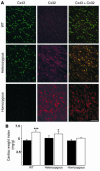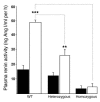Connexin43-dependent mechanism modulates renin secretion and hypertension
- PMID: 16440062
- PMCID: PMC1350996
- DOI: 10.1172/JCI23327
Connexin43-dependent mechanism modulates renin secretion and hypertension
Abstract
To investigate the function of Cx43 during hypertension, we studied the mouse line Cx43KI32 (KI32), in which the coding region of Cx32 replaces that of Cx43. Within the kidneys of homozygous KI32 mice, Cx32 was expressed in cortical and medullary tubules, as well as in some extra- and intraglomerular vessels, i.e., at sites where Cx32 and Cx43 are found in WT mice. Under such conditions, renin expression was much reduced compared with that observed in the kidneys of WT and heterozygous KI32 littermates. After exposure to a high-salt diet, all mice retained a normal blood pressure. However, whereas the levels of renin were significantly reduced in the kidneys of WT and heterozygous KI32 mice, reaching levels comparable to those observed in homozygous littermates, they were not further affected in the latter animals. Four weeks after the clipping of a renal artery (the 2-kidney, 1-clip [2K1C] model), 2K1C WT and heterozygous mice showed an increase in blood pressure and in the circulating levels of renin, whereas 2K1C homozygous littermates remained normotensive and showed unchanged plasma renin activity. Hypertensive, but not normotensive, mice also developed cardiac hypertrophy. The data indicate that replacement of Cx43 by Cx32 is associated with decreased expression and secretion of renin, thus preventing the renin-dependent hypertension that is normally induced in the 2K1C model.
Figures








Similar articles
-
Connexin40 regulates renin production and blood pressure.Kidney Int. 2007 Oct;72(7):814-22. doi: 10.1038/sj.ki.5002423. Epub 2007 Jul 11. Kidney Int. 2007. PMID: 17622273
-
Connexins 40 and 43 are differentially regulated within the kidneys of rats with renovascular hypertension.Kidney Int. 2001 Jul;60(1):190-201. doi: 10.1046/j.1523-1755.2001.00786.x. Kidney Int. 2001. PMID: 11422751
-
Inducible deletion of connexin 40 in adult mice causes hypertension and disrupts pressure control of renin secretion.Kidney Int. 2015 Mar;87(3):557-63. doi: 10.1038/ki.2014.303. Epub 2014 Sep 17. Kidney Int. 2015. PMID: 25229336
-
Expression and function of connexins in the epidermis, analyzed with transgenic mouse mutants.Eur J Cell Biol. 2004 Dec;83(11-12):647-54. doi: 10.1078/0171-9335-00422. Eur J Cell Biol. 2004. PMID: 15679109 Review.
-
Renal connexins and blood pressure.Biochim Biophys Acta. 2012 Aug;1818(8):1903-8. doi: 10.1016/j.bbamem.2011.05.023. Epub 2011 Jun 7. Biochim Biophys Acta. 2012. PMID: 21683057 Review.
Cited by
-
Hypertensive Nephropathy: Unveiling the Possible Involvement of Hemichannels and Pannexons.Int J Mol Sci. 2022 Dec 14;23(24):15936. doi: 10.3390/ijms232415936. Int J Mol Sci. 2022. PMID: 36555574 Free PMC article. Review.
-
Gap junction-mediated regulation of endothelial cellular stiffness.Sci Rep. 2017 Jul 21;7(1):6134. doi: 10.1038/s41598-017-06463-x. Sci Rep. 2017. PMID: 28733642 Free PMC article.
-
Angiotensin II-Induced Mesangial Cell Damaged Is Preceded by Cell Membrane Permeabilization Due to Upregulation of Non-Selective Channels.Int J Mol Sci. 2018 Mar 23;19(4):957. doi: 10.3390/ijms19040957. Int J Mol Sci. 2018. PMID: 29570626 Free PMC article.
-
Who and where is the renal baroreceptor?: the connexin hypothesis.Kidney Int. 2009 Mar;75(5):460-2. doi: 10.1038/ki.2008.536. Kidney Int. 2009. PMID: 19219002 Free PMC article.
-
The role of calcium in the regulation of renin secretion.Am J Physiol Renal Physiol. 2010 Jan;298(1):F1-F11. doi: 10.1152/ajprenal.00143.2009. Epub 2009 Jul 29. Am J Physiol Renal Physiol. 2010. PMID: 19640903 Free PMC article. Review.
References
-
- White TW, Bruzzone R, Paul DL. The connexin family of intercellular channel forming proteins. Kidney Int. 1995;48:1148–1157. - PubMed
-
- Meda, P., and Spray, D. 2000. Gap junction function. In Gap junctions, advances in molecular and cell biology. Volume 30. E.L. Herzberg, editor. JAI Press. Greenwich, Connecticut, USA. 263–322.
-
- Saez JC, Berthoud VM, Branes MC, Martinez AD, Beyer EC. Plasma membrane channels formed by connexins: their regulation and functions. Physiol. Rev. 2003;83:1359–1400. - PubMed
-
- Bruzzone R, White TW, Paul DL. Connections with connexins: the molecular basis of direct intercellular signaling. Eur. J. Biochem. 1996;238:1–27. - PubMed
-
- Bruzzone R, White TW, Goodenough DA. The cellular Internet: on-line with connexins. Bioessays. 1996;18:709–718. - PubMed
Publication types
MeSH terms
Substances
Grants and funding
LinkOut - more resources
Full Text Sources
Medical
Molecular Biology Databases

